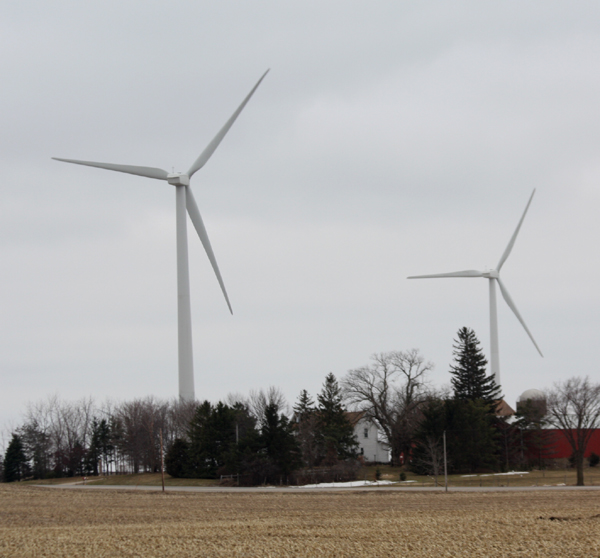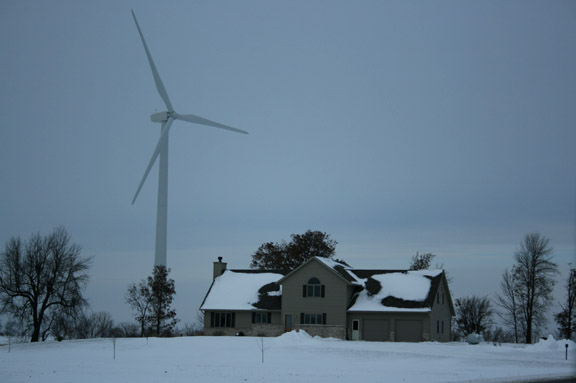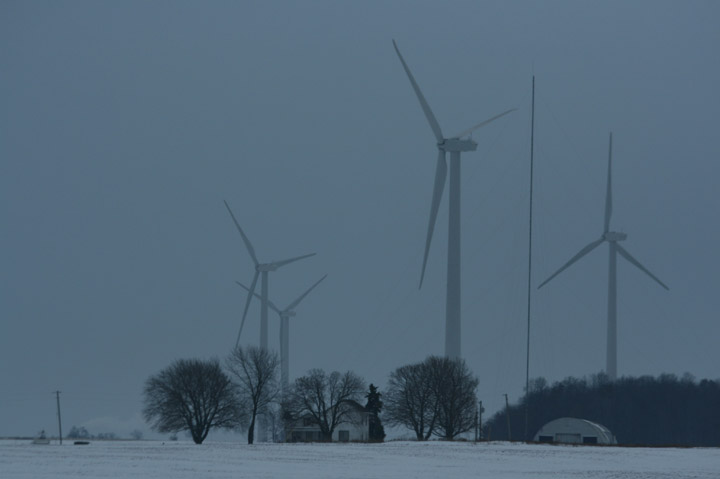12/27/09 What is the effect of a wind farm on property values? A tale of two studies and a story problem

Turbine impact studies conflict
PROPERTY VALUES: Local opponents say wind farms harmful
Opponents of wind farm development in Jefferson County have touted property value decline as a possible harm.
But that argument, or any counterclaim, is getting little support from experts. Two studies on property values around wind farms were released in 2009, but had very different results.
The U.S. Department of Energy's Lawrence Berkeley National Laboratory supported a study that found no measurable value loss linked to wind farms in sales data from 7,459 sales of single-family homes within 10 miles of 24 wind farms in nine states.
Meanwhile, Appraisal Group One, Oshkosh, Wis., conducted a smaller study of vacant land sales in and around two wind farms for the Calumet County Citizens for Responsible Energy this year. In a year where property values suffered nationally, that study found the average loss in value at 40 percent in one wind project's area and 30 percent in the other.The Energy Department study, led by Ben Hoen, looked at home sales from 1996 to 2007. It compared the characteristics of the homes in several models.
"Specifically, neither the view of the wind facilities nor the distance of the home to those facilities is found to have any consistent, measurable and statistically significant effect on home sales prices," the report said.
The number of transactions, which included 125 within a mile after construction and about 60 within 3,000 feet, decreased the margin of error.
"It was more data than had been collected before," Mr. Hoen said. "We tried a lot of different ways of testing the data. It's the most complete analysis of the subject to date."
But Kurt C. Kielisch, president of Appraisal Group One, said the sheer number of sales included in the Energy Department study may have clouded the results.
"You can lose the distinction in numbers," he said. "You only need 20 to 30 good sales for a very good study."
His appraisal firm's study included sales of 12 vacant parcels inside two wind projects' boundaries and 90 vacant parcels outside the boundaries. All of the parcels were within one-half mile of turbines and had a view of them.
"It is logical to conclude that the factors that created the negative influence on vacant land are the same factors that will impact the improved property values," the study said. "Therefore, it is not a leap of logic to conclude that the impact of wind turbines to improved property value would also be negative."
Mr. Hoen said the Energy Department study has its advantage in the high number of sales included.
"In other studies the effect exists based on the surveys of Realtors," he said. "In our study, we concentrated only on actual transactions."
Appraisal Group One did include a survey of real estate agents. Mr. Kielisch argued that the results tracked very closely with his sales data.
"Every appraiser gets opinions from Realtors," Mr. Kielisch said. "They are in the trenches and we are the observers."
The survey asked about property value on parcels within 600 feet, 1,000 feet and one-half mile of the turbines. The agents agreed there would be lost value for all the lots, vacant or improved. How much, between 24 percent and 43 percent, depended on the distance.
Based on his results, Mr. Kielisch suggested that property owners ask for a property value assurance agreement, where a developer would pay the difference between a property's sale price and the value of comparable property outside of a wind power development if the property loses value.
"If you really believe that the value won't decline, guarantee that fact," he said.
Both researchers agreed future studies should include some data on how long properties are on the market. Other areas to consider include whether secondary residences and certain scenic vistas are more sensitive, Mr. Hoen said.
NOTE FROM THE BPWI RESEARCH NERD:
Story Problem: If the DOE report used sales data from 7,459 sales of single-family homes within 10 miles of 24 wind farms in nine states, and 125 of those homes were within a mile of the wind farm after construction and about 60 of those were within 3,000 feet, what percentage of the homes in this study are located within one mile of a wind farm?
ANSWER: 1.67 %
Extra Credit: What percentage of the homes in this study were located within 3000 feet?
ANSWER: 0.8 %
Extra extra credit: What is the setback from a home in Wisconsin?
ANSWER: 1000 feet or less.


